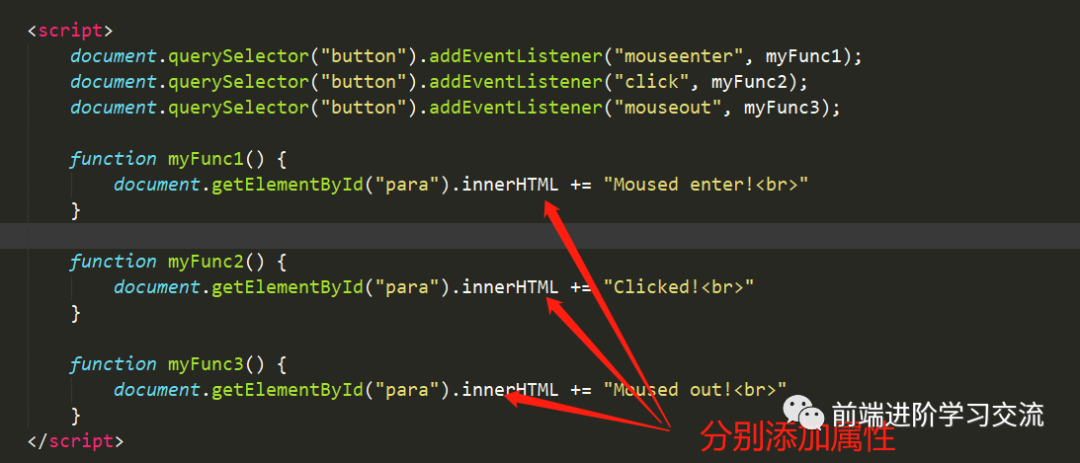一、addEventListener()方法
addEventListener()方法将事件处理程序附加到指定的元素。
可以重写随机颜色,如下所示:
例:
<html> <title>项目(nhooo.com)</title>
<body style="background-color: aqua;">
<p>单击下面的按钮以更改文档的背景颜色:</p>
<button>点我改变背景颜色</button>
<script> let btn = document.querySelector("button"); btn.addEventListener("click", bgChange);
function bgChange() { let color = "rgb(" + random(255) + "," + random(255) + "," + random(255) + ")"; document.body.style.backgroundColor = color; }
function random(number) { return Math.floor(Math.random() * (number + 1)); }</script>
</body></html>

将addEventListener()方法附加到按钮上。addEventListener()接受两个必填参数-要监听的事件和监听器回调函数。
1. 语法
element.addEventListener(event, listener, useCapture)
代码解析:
第一个参数是事件的类型(例如“ click”或“ mousemove”)。
第二个参数是事件发生时我们要调用的监听函数。
第三个参数是一个布尔值,指定是使用事件捕获。此参数是可选的。
注意:
不要为事件使用“ on”前缀。使用“ click”代替“ onclick”。
2. 将事件监听添加到元素
将所有代码放入addEventListener()方法中的匿名函数中是非常合适的,如下所示:
<script>let para = document.querySelector("#para");
para.addEventListener("click", function() {this.innerHTML = "Hello world";});</script>
还可以引用外部“命名”函数:
示例
<script>let para = document.querySelector("#para");para.addEventListener("click", changeText);
function changeText() {para.innerHTML = "Hello world";}</script>

3. 将多个事件监听添加到同一元素
事件监听似乎与事件处理程序属性非常相似,但是它们有一些优点。我们可以在同一元素上设置多个事件监听,如以下示例所示:
<script>document.querySelector("button").addEventListener("click", myFunc);document.querySelector("button").addEventListener("click", anotherFunc);
function myFunc() {document.body.style.backgroundColor = "coral"; //改变背景颜色}
function anotherFunc() {document.body.style.fontSize = "2rem"; //改变字体大小}</script>

可以向元素添加不同类型的事件:
示例


4. 传递参数
传递参数值时,请使用匿名函数,该函数使用参数调用指定的函数:
例
var btn = document.querySelector("button"); btn.addEventListener("click", function() { myFunc(x, y);});

5. 将事件监听添加到Window对象
此外,可以addEventListener()在文档和窗口对象上使用。
本示例使用以下addEventListener()方法将click事件附加到文档:
document.addEventListener("click", function() {alert("Hello World!!!");});
使用该addEventListener()方法将调整大小(resize)事件附加到窗口:
window.addEventListener("resize", function() {box.innerHTML = Math.random();});

当前,事件监听是处理JavaScript中事件的最常见和首选方式。
二、removeEventListener()方法
可以使用该removeEventListener()方法从元素中删除一个或所有事件。
语法:
var box = document.getElementById("para");
// Attach an event handler to a P element with id="para" box.addEventListener("mousemove", myFunc);
// Remove the event handler from a P element with id="para" box.removeEventListener("mousemove", myFunc);
案例:
<script> // 使用以下代码将事件处理程序附加到 id="para" var box = document.getElementById("para"); box.addEventListener("mousemove", myFunc);
function myFunc() { box.innerHTML = Math.random(); }
function removeHandler() { //从id="para"的P元素中删除事件处理程序 box.removeEventListener("mousemove", myFunc); }</script>

第一个参数是事件的类型(例如“ click”或“ mousemove”)。
第二个参数是事件发生时我们要调用的函数。

